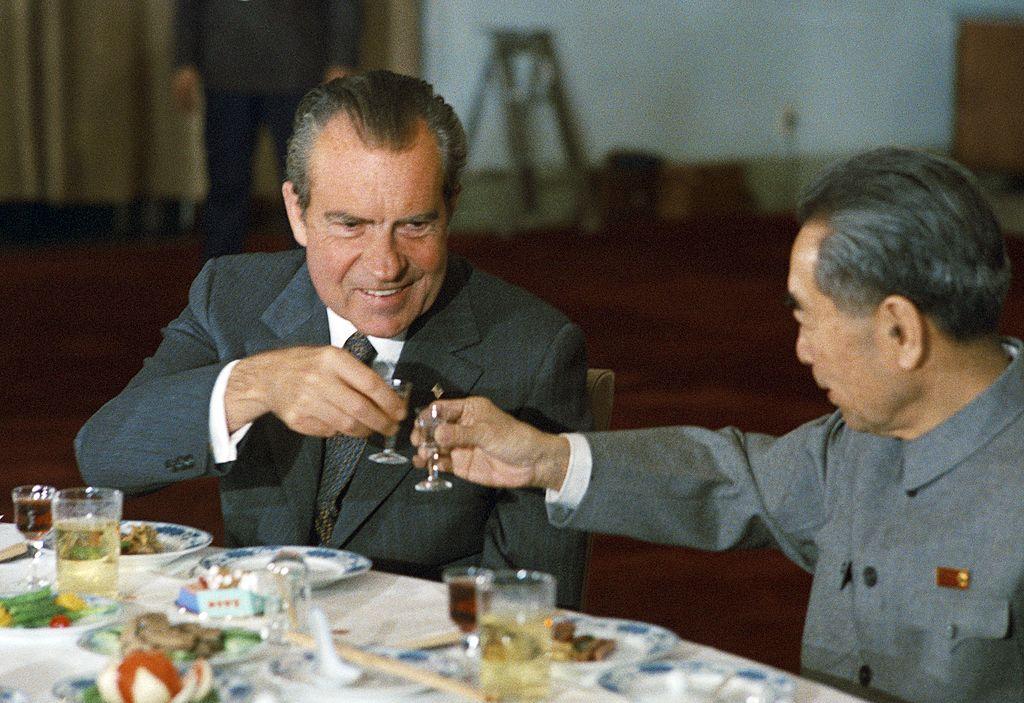
With China currently the only country capable of unseating America as the leading global power, many in Washington may wish that US President Richard Nixon had never made his historic trip to China 50 years ago this week. In their revisionist narrative, it was Nixon’s meeting with Chinese Communist Party Chairman Mao Zedong, and the policy of engagement it initiated, that helped make China an economic superpower and a geopolitical threat to America. For these critics, the Nixon visit, far from being a stroke of diplomatic genius, was one of history’s greatest strategic blunders.
But such revisionist arguments discount the substantial benefits the United States gained from Nixon’s gambit and the decades of US–China engagement that followed. Although China didn’t directly assist the US, Nixon’s visit shifted the perceived Cold War balance of power and influenced the strategic calculations of both the Soviet Union and North Vietnam, resulting in immediate US gains. America and the Soviet Union signed the first nuclear arms control treaty (SALT I) in May 1972, and the US extricated itself from Vietnam a year later.
Engagement with China also yielded significant longer-term geopolitical and economic dividends for the US. Regional tensions in East Asia eased dramatically, mitigating the Chinese threat to vital US interests there, while the US–China quasi-alliance against the Soviet Union in the 1980s contributed to America’s victory in the Cold War.
On the economic front, lower-priced imports from China helped to contain US inflation, while US exports to China grew rapidly and American corporations extended their reach into the country’s domestic market. Although competition from Chinese imports led to the loss of US manufacturing jobs, it’s difficult to argue credibly that the US hasn’t reaped economic benefits from its engagement policy.
To be sure, China has gained substantially more than the US in economic terms from the bilateral relationship. But that was mainly due to the process of reform and opening launched by Deng Xiaoping in 1979. Nobody, least of all Nixon or Mao, could have foreseen the Chinese economic miracle that was to materialise in the decades after their fateful encounter. At the time of Nixon’s visit, Deng was in the political wilderness, performing menial labour in Jiangxi province. It was Mao’s death in 1976 and Deng’s subsequent political rehabilitation and elevation that altered the course of Chinese history.
If the Nixon–Mao meeting made any difference in terms of China’s rise, it was by saving Deng the trouble of having to start from scratch in normalising relations with the US. Without the Sino-American rapprochement that Nixon and Mao engineered (mainly to counter the shared Soviet threat), Deng would have needed more time and effort to persuade the West to embrace China, which had been a pariah state before 1972.
Revisionists also seem to forget that the US–China relationship forged by Nixon rested on fragile foundations, and that America’s engagement policy was in constant danger of being derailed by actions or events in both countries. Deng himself nearly brought US–China engagement to an end when he crushed the peaceful pro-democracy demonstrations in Tiananmen Square in June 1989. Only the intervention of President George H.W. Bush, who had served as the second US envoy to China from 1974 to 1975, saved the policy, at the cost of being criticised for kowtowing to the ‘butchers of Beijing’.
Nixon’s legacy was imperilled again in 2001, when the neo-conservatives who held sway in President George W. Bush’s administration decided that a fast-growing China posed a geopolitical threat and must be confronted. But 9/11 intervened before they could implement a new policy of containment. For reasons that remain elusive, the same neo-cons switched strategic focus and invaded Iraq in 2003, trapping the US in the Middle East quagmire for more than a decade.
Despite the volatility in US–China relations, the engagement policy crafted by Nixon and his national security adviser, Henry Kissinger, served the interests of both countries until about a decade ago. But China’s assertiveness and expansionism under President Xi Jinping has made sustaining that approach impossible. Nonetheless, a policy that helped produce 40 years of peace, prosperity and stability between two former staunch foes must be considered a resounding success.
With the US and its allies now facing an unfriendly China, it’s tempting to imagine repeating Nixon’s gambit, this time with an ironic twist. Specifically, some commentators in Washington think that the US should do a ‘reverse Nixon’ and try to pry Russian President Vladimir Putin from Xi’s embrace.
Unfortunately, those advocating such a strategy overlook a crucial difference with the Nixon era. The concession that Putin seems to be demanding, now with the threat of war in Ukraine, is a fundamental revision of the post–Cold War settlement in Europe. Few Western leaders, including US President Joe Biden, appear willing to accept such a price in return for weaker Sino-Russian ties.
Likewise, revisionists appear to have forgotten that, other than risking a domestic political backlash (which never occurred), Nixon didn’t have to make any real, let alone painful, concessions to China (the Taiwan issue was shelved with the help of linguistic legerdemain). Fifty years on, his visit to Beijing remains, as Americans would say, a geopolitical no-brainer.